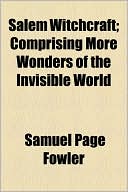

 |

|

The average rating for Salem Witchcraft based on 2 reviews is 4.5 stars.
Review # 1 was written on 2010-06-13 00:00:00 Brent S Adkins Brent S AdkinsNot something to read front to back necessarily, but very interesting. He is a master of revisionist history, and his accounts of various important New World men reveals a lot about the Puritan mindset, particularly the didactic panic of one trying to (re?)convert the wayward youth. I think I find this kind of text so engaging because it resonates with my own experiences as LDS; i.e., it's not the first time I have had experience with this genre. :) |
Review # 2 was written on 2012-03-23 00:00:00 Quentin Wensveen Quentin WensveenThe first and most important thing to know about this book is that it was produced by a university press'a high-end, well known university press and, in this case, one whose editors, book designers, and advertising copywriters were better at their jobs than were the authors, but a university press nonetheless. That fact wafts off every page. Indeed, it's interesting to speculate about who the writers and publisher imagined the audience for this book to be. Unearthing Gotham isn't scholarly enough to appeal to professional archeologists and historians, and it's entirely too dull to be a popular trade book (though, to judge from the way the product is externally presented and packaged, that is exactly what Yale Press had in mind). In fact, Cantwell and Dizerega-Wall seem to be doing their intentional best to make sure none of the information they present ever comes to life: rather, it unfolds in the dry, detached, dispassionate tones of a first-year college lecturer. In what is blatantly an attempt to satisfy some sort of political agenda, the first third of the book is given over to a discussion of the Native Peoples who lived for millennia in the area that is now the 5 boroughs of New York. The trouble is, the physical evidence of thousands of years of native presence and culture could apparently now be contained in an average-sized garage; in other words, it has almost all been destroyed, built-over, lost. That's a shame, but it's not a good reason to make us read a hundred pages in which the authors have substantially this to say: "we don't actually know about New York, but over there they did this, and other Native Peoples did that, and we can conjecture that maybe they were like this." In a word, it's a bore. Okay, one thinks, when we get closer to the present, the archeological evidence will be more complete and the history will get more interesting. And yet, no. To be sure, there are more sites, more finds, more evidence, but the lives behind the relics remain as remote and shadowy as ever; the authors simply don't know how to put flesh on those bones. Cantwell and Dizerega-Wall present graphs dedicated to such things as the percentage of clay pipe fragments relative to ceramic fragments in privy sites. They make much of analyses of the kinds of dishes used by people in various geographical areas and of various classes and ethnicities, assuring us that such data tell us a great deal about social distinctions and about the tenor every day life. They do? Such as? That lots of pipe fragments suggests that a pub instead of a house stood on the site? That people over there liked to serve tea to their guests, while those other people tended to invite people for dinner? That's the kind of fascinating insight for which the reader is expected to plow through 300 pages of densely written prose? Other than providing the material for PhD dissertations that one heartily suspects were never read by anyone who didn't have to read them, most of what is presented in Unearthing Gotham is similarly unhinged from deeper meaning or analysis and it simply isn't possible for the non-archeologist to develop the slightest enthusiasm for it. The many tiny, murky photographs or the maps reproduced on such a small scale that they can't be read don't help (and that's one blazing indication of a university press's legendary parsimony). The truly great "popularizers of science" (of which there are more than a few) know how to bring even technical information to life for a mass audience; sadly for the reader, and unfortunately for such a potentially engaging topic, Cantwell and Dizerega-Wall never even come close. |
CAN'T FIND WHAT YOU'RE LOOKING FOR? CLICK HERE!!!